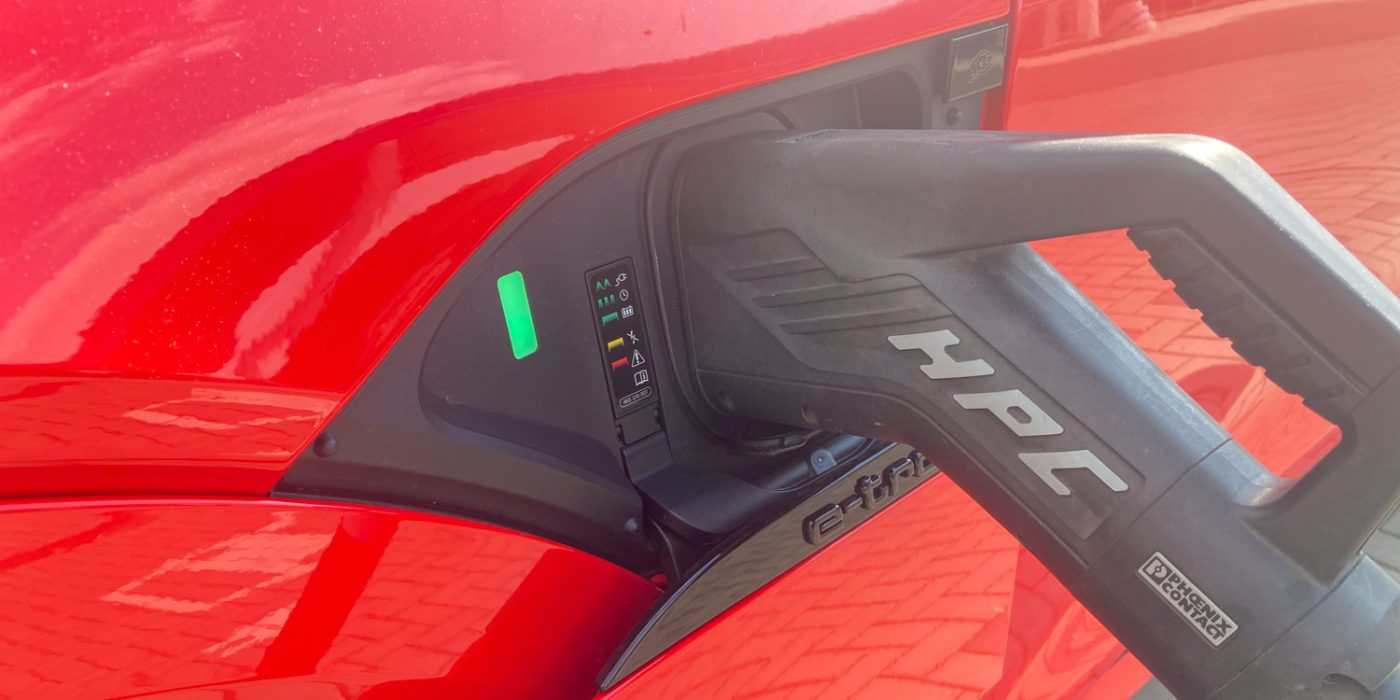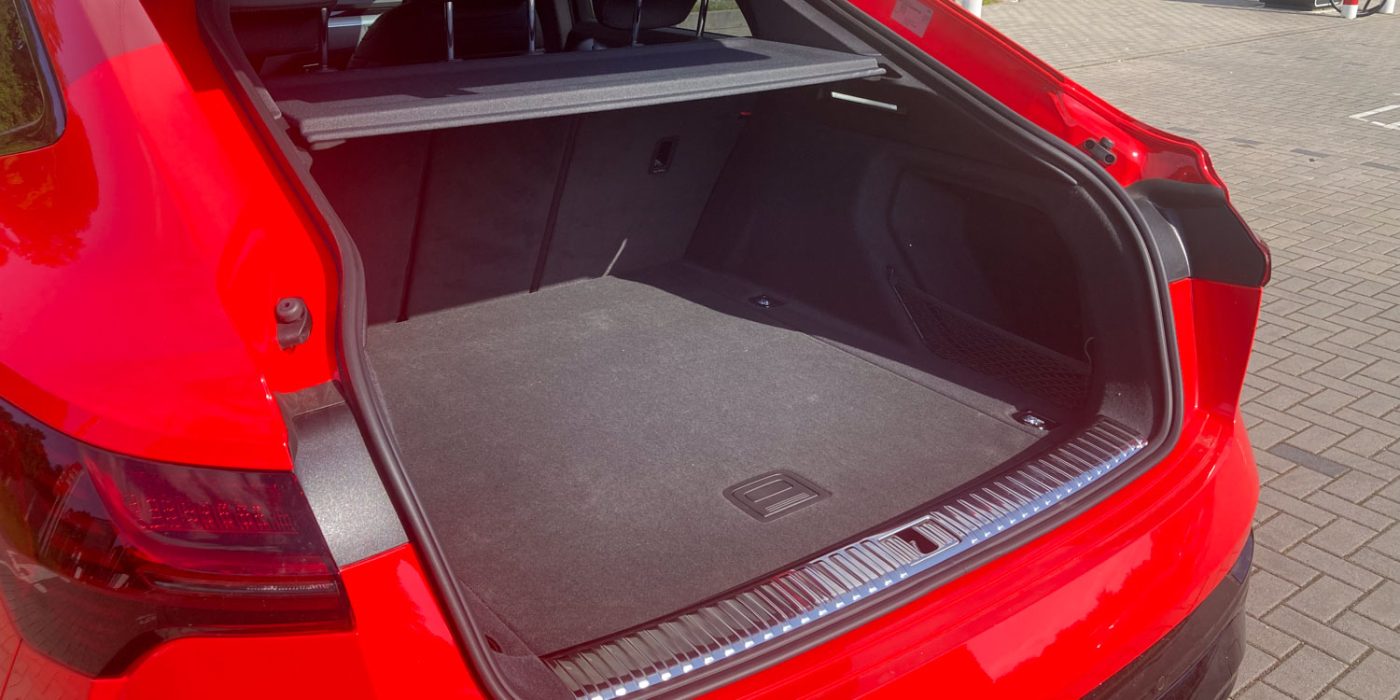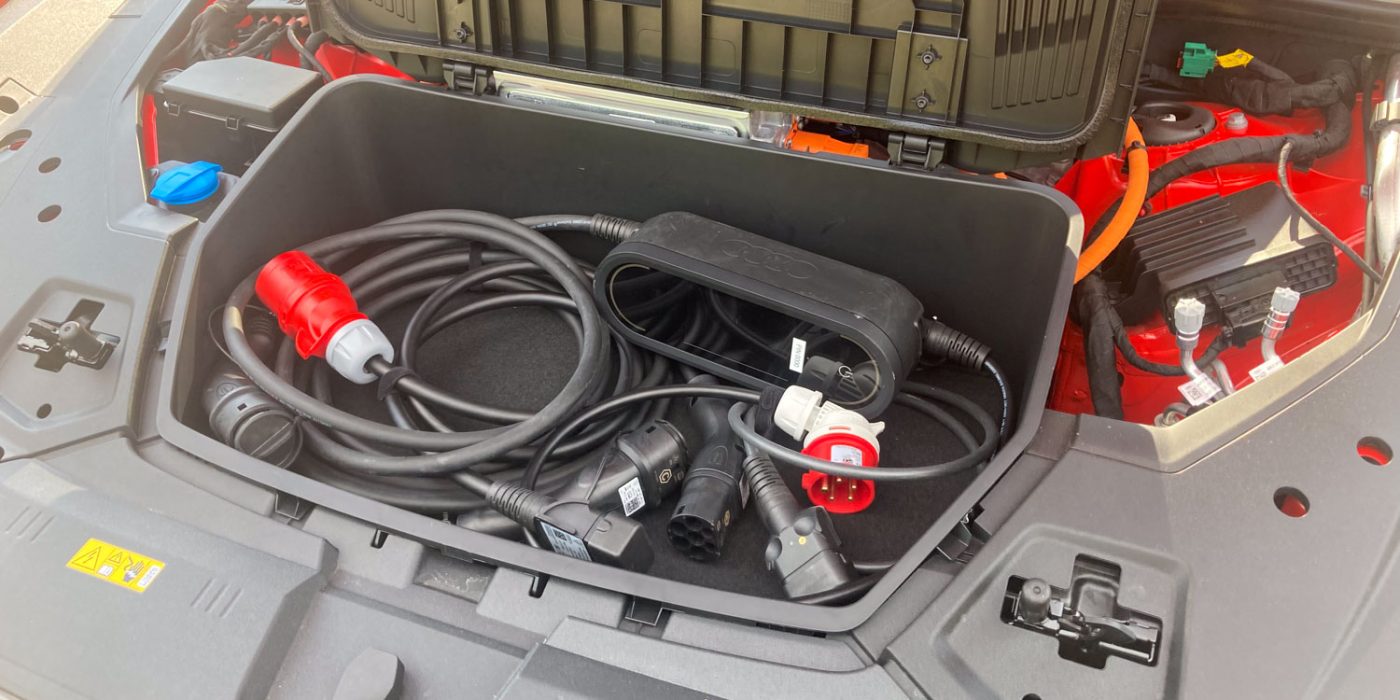
Audi Q8 e-tron: Twice as good as a Model Y?
The 2024 Audi Q8 Sportback e-tron parked in front of our house costs 115,400 euros. It is painted in ‘Soneira Red Metallic’ and has a new 114 kWh battery. Admittedly, even with this battery and the 300 kW drive, the Q8 e-tron Sportback is available from 87,550 euros. But that a premium car from a German manufacturer can be customised with all kinds of (high-margin) extras in terms of paint, rims and leather seats has practically become part of the business model. For example, the ‘Soneria Red’ paint costs an extra 1,800 euros, details such as the red brake callipers cost 400 euros, the black exterior mirror housings 350 euros, and so on. In other words, you must pay if you don’t want the standard colour.
However, many features that customers expect in a car in this price range cost extra. For example, electrically adjustable and heated exterior mirrors (350 euros), an automatically dimming interior mirror (175 euros), and even the seat heating for the front seats has to be paid for (350 euros). The seat ventilation costs another 800 euros extra, the “individual contour seats” 2,500 euros and the ‘Valcona’ leather 2,350 euros. The “comfort centre armrest in the front” costs only 200 euros. With a few technical features, the gross list price quickly reaches six figures.
A Tesla Model Y Long Range – if you take the drive variant with the longest range, as with the Q8 e-tron – is available for as little as 57,667.50 euros before subsidies. Admittedly, the rough calculation we made at the beginning with the double price only works for the Model Y Long Range without any extras. If you add the ‘Midnight Cherry Red’, the black 20-inch wheels and the extended Autopilot to get to a comparable level, the Tesla also costs 66,867.50 euros. No longer half as much as the red Q8 e-tron, but still significantly cheaper.
Audi has a better range on paper
On paper, a comparison that is still important for many customers goes to the Audi: the Sportback has a WTLP range of up to 600 kilometres, the Tesla up to 565 kilometres – in both cases, however, equipment-specific features are not taken into account, these are the values of the most economical equipment. But it is also a fact that with 114 kWh (106 kWh net), the Audi needs a much larger battery to surpass the Model Y in terms of standard range. But because the Tesla is more than 700 kilograms lighter, the Long Range accelerates (again, on paper) 0.6 seconds faster than the 55 Q8 e-tron.













While you are unlikely to feel the six-tenths of a second in everyday driving, after several thousand kilometres in the Model Y and a few hundred kilometres in the Q8 e-tron, we were able to determine that the practical range for both vehicles is roughly between 300 and 400 kilometres – depending on the driving profile and environment. Of course, this also means that the consumption of the Q8 e-tron is a good deal higher – between 5 and 8 kWh per 100 kilometres depending on the driving style, and sometimes even more on short journeys or fast motorway stages. The energy costs are correspondingly higher for every kilometre driven.
Consumption was already not a strong point in the e-tron quattro. The Audi concept with asynchronous motors is not very efficient, especially in the partial load range. With the model update to the Q8 e-tron, the engineers have optimised the drive: The stator of the electric motor on the rear axle now has 14 windings instead of twelve. With the same current input, the motor generates a stronger magnetic field, ensuring a higher motor torque. If it is not used, the electric motor requires less current to build up torque, thus reducing consumption and increasing the range – a little. But even the two additional windings do not make the Audi an example of efficiency. A consumption of less than 20 kWh/100km (according to the on-board computer) was only possible with decidedly restrained driving in eco mode. However, 24-25 kWh/100km is more the rule than the exception.
Energy costs may only play a minor role for vehicles in this class. Still, consumption is nevertheless one of the important factors for long-distance suitability. Range and consumption are again secondary if you use the Q8 e-tron for commuting and can charge at the wallbox at home or on the company premises. For long distances, there is another point to consider: fast charging.
Q8 e-tron falters on the charging curve
Regarding fast charging, the e-tron quattro has been known for its exceptional charging curve. The 95 kWh battery is still offered as the Q8 50 e-tron and could be charged with 150 kW to just under 90 per cent. However, Audi has now said goodbye to this unique charging curve. Although the peak power is 170 kW at around 60 per cent SoC (State of Charge), it drops constantly after that. At least that is what a diagram of the charging curve shows, which Audi itself published for the premiere of the Q8 e-tron.
However, we never saw the 170 kW mark, despite navigation to the charging station and optimum temperatures of just over 20 degrees. It stopped at 148 kW – more or less the same as before. Moreover, below 35 per cent, the charging curve is not at this level, and it is capped at 70 per cent SoC, where the full charging power was still available for a long time with the smaller battery before the facelift.
In our hypothetical comparison with the Model Y Long Range, there is no real winner for fast charging. Tesla is ahead up to around 35 per cent, but then the curve drops constantly, while the Audi reaches its plateau at 148 kW. However, since the more efficient Tesla has to recharge less energy to reach 80 per cent SoC, the standard charging process from ten to 80 per cent takes around 30 minutes in both cases. However, the Tesla has clear advantages if you quickly recharge from ten to 40 per cent at the last charging stop of a long journey to reach your destination.
So, do you have to pay a six-figure price for the Audi to have a comparable practical range and charging time?
Of course, the comparison is not quite that simple. For example, a good long-distance experience requires proper route guidance and charge planning. The suggestions Audi makes are quite solid. With the battery charged at 90 per cent, Berlin and Copenhagen, for example, can be reached from Düsseldorf with two charging stops each – in the case of the route to Berlin, only 34 minutes of total charging time are calculated. That is at a perfectly acceptable level and corresponds more or less to the breaks that one should take anyway on a route of almost 600 kilometres.
The route planning process itself is a little more cumbersome in the Audi because the vehicle first calculates a route before the driver has to confirm that the destination cannot be reached with the current SoC and that the system should automatically pick out charging stops. That is easier with the Tesla navigation system as long as you use Superchargers. If you want to charge at the charging stations of other CPOs, the Tesla is more complicated.
The comparison of software functions can be continued almost indefinitely: If you want to find a charging station nearby, Tesla offers the better function. Here you can choose between one, two or three lightning bolts (AC, DC or HPC), and the car displays all suitable matches. When we searched for the nearest HPC charging station in the Audi for some random tests, it suggested only one HPC charging station – as well as an AC charging station and a DC charger from Elli with just 20 kW. Audi did not provide a selection of HPC charging stations.
No surprise there: Audi has the higher-quality interior
One reasonably simple software feature where the Tesla comes out on top is sending a destination from the smartphone to the car. In the Model Y, route guidance to the desired destination immediately activates when you enter the car. In the Audi, the address only appears under “Last destinations” and, in our test, sometimes with a delay of several minutes. Even though the vehicle had, according to its display, access to the internet. Getting in and hitting the road immediately is more pleasant in the long run than it might sound at first.
A small detail on the side: Audi developers neglected to adjust the vehicle’s graphics when programming the 3D view of the vehicle based on the images from the 360-degree cameras. There, the e-tron quattro features its striking radiator grille. It does not detract from the functionality and is not intended to be a point against Audi. Due to the positioning of the cameras, the Tesla does not even have a 360-degree view, let alone 3D. However, since the display is much larger, the images displayed by the cameras are much more detailed.
But then there are the areas where Audi is miles ahead. The quality and materials in the Model Y from Grünheide that we drove are no longer at the level that Tesla once held. Compared to the Q8 e-tron, the two vehicles are worlds apart. Yes, the surcharge list with all its customisation options plays a role. Tesla only offers a choice of black or white. If, for example, you want the plastic surfaces on the steering wheel to have a carbon look, you have to stick on a trim from the accessories trade in a 60,000-euro car.
The Audi interior is of high quality, even if one questions the placement of the black high-gloss plastic. But: there were no noteworthy changes inside after the model update. Features such as games or video streaming for the charging break did not make it into the Q8 e-tron.
You feel the space limitations of Audi’s combustion engine platform
While games and videos can be accessed on a tablet or mobile phone while at the charger, some things cannot be made up for. Although the Q8 e-tron is significantly larger at 4.92 metres than the Model Y, it is not as airy inside. The storage compartments are smaller, and the smartphone has to be inserted vertically into the inductive charging holder in the centre console – in the Tesla, two inductive charging pads are located under the touchscreen. The rear seat is not cramped but less roomy. The black headliner in the Audi test car naturally impacts the feeling of space compared to the Tesla glass roof. But the Q8 e-tron also offers less in the way of boot space. The frunk is smaller than in the Tesla but is sufficient for the charging cables. In terms of towing capacity, the Q8 e-tron takes the lead with 1,800 to 1,600 kilograms.
That leaves one aspect: driving comfort. Here, the Audi is once again on a different level. That applies not only to the tuning of the air suspension (although there are small compromises here as well) but, above all, to the noise level. It is noticeably quieter in the Audi, making long-distance travel and everyday journeys much more pleasant. The large Tesla glass roof is, of course, a disadvantage regarding interior acoustics.
As with the e-tron quattro, there is little to criticise about the chassis. Of course, there are some situations where you feel the kerb weight of around 2.7 tonnes, like when turning in on a wet road. All in all, the weight is hardly noticeable. Even in fast bends, the car steers neutrally and precisely. In “Eco” mode, however, the air suspension is lowered somewhat (to optimise aerodynamics). There is less suspension at the “Dynamic” mode’s chassis height, and you must thus choose between the best possible aerodynamics and the higher suspension comfort on the motorway. However, this is a choice that the Model Y driver with the steel suspension does not have at all.
Conclusion
Presumably, only a few customers will waver between a Q8 e-tron and a Model Y. This short comparison based on our practical experience is not intended as a purchasing guide. We just want to show where the differences lie: Audi is still far ahead in classic automotive engineering with quality, comfort and fine-tuning, which is hardly surprising. However, in some aspects of the electric drive and the software, Tesla offers a product that is at least equal, often even better – for considerably less money.
And digital features are becoming increasingly important for new customers. In this respect, another comparison will be interesting when Audi launches the new Q6 e-tron based on the PPE electric platform. The Q6 should not only be more comparable with the Tesla in terms of price but also addresses some of the criticisms of the Q8 e-tron with its presumably more efficient 800-volt-based drive system and the space advantages of a pure electric platform. Coupled with the undisputedly good classic automotive engineering, this could result in a good vehicle – if the software is ready.




0 Comments